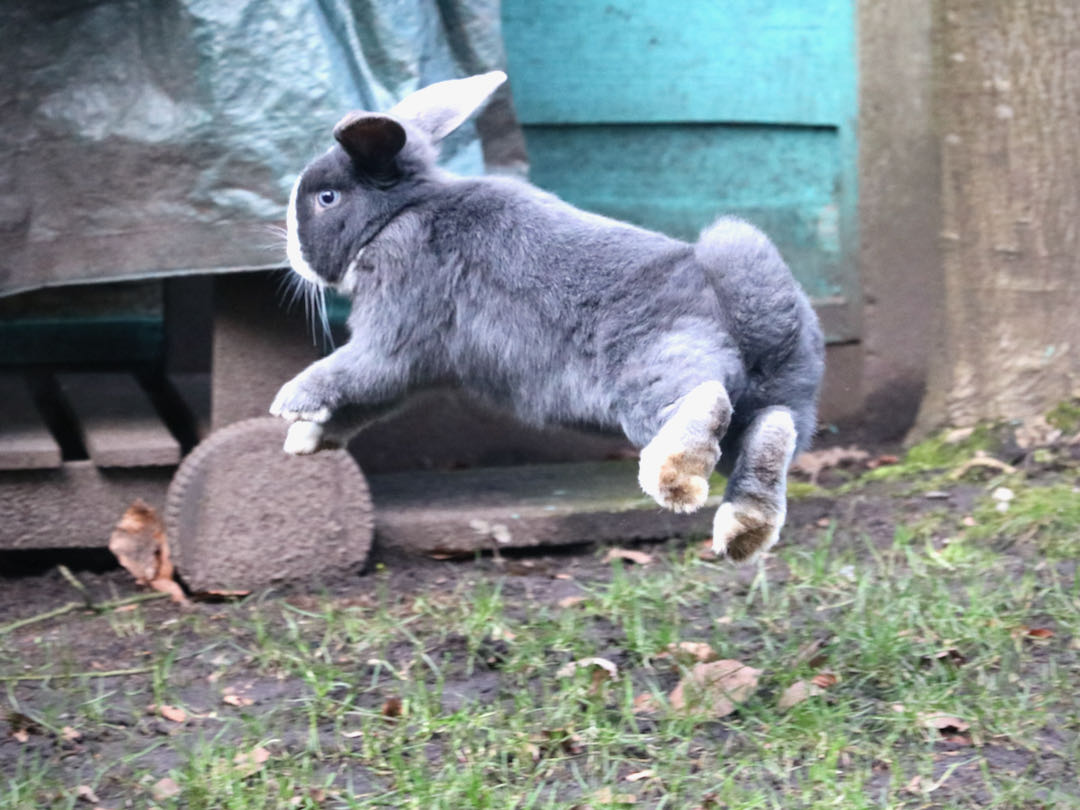There are three possible reasons you’re here.
First, you’re trying to keep wild rabbits out of your garden or yard.
Second, you’re a rabbit owner, worried about your bunnies escaping into the wild (or parts of the garden or house they might chew up).
Or third, you are simply curious about bunnies!
My parents have the first problem – they have rabbits eating up their lovingly planted flowers.
I worry about the second problem – I don’t want my bunnies to escape onto nearby roads and lanes – and I am also, like some of you in the third category, simply curious about bunnies.
So this article is based not only on hours of research to make sure the information is reliable, but also my own practical experience and needs.
How high can rabbits jump?
Rabbits can jump over 3 feet (about 1m) high. The world record for a rabbit jump stands at 39.2 inches (99.5cm), or 3 feet 3.2 inches, but there are anecdotal reports of rabbits jumping as high as four feet. However, fences higher than 3 feet high will deter most bunnies. The famous rabbit-proof fence in Australia was 3 feet high.
The official world record for rabbit jumping
The official world record for the rabbit high jump currently stands at 99.5cm (39.2 inches).
The record for the rabbit high jump was set in June 1997 in Denmark by a black and white bunny called Mimreslunds Tösen, owned by Tyne Bygom (there are more details about the high jump competition in resources provided by someone from the same club, Aase Bjerner – find his website here, with photos of Tösen jumping), in an official competition.
Yes, there are official high jump competitions for rabbits. No, I didn’t know that, either.
The competitive sport is called rabbit hopping (or, in Danish, kaninhop. Kanin is the Danish for rabbit). It began in Sweden around 1980 and spread to Denmark.
There are four competitions – a hurdles sprint; a crooked hurdles (ie, not in a straight line); long jump and high jump.
Here’s the Danish high jump championships from 2014:
The idea has now spread to other countries, and England has hosted a bunny Grand National in Harrogate. Rabbit hopping has also spread to Australia, as this report from 2019 shows:
Feedback from rabbit owners on how high their rabbits can jump
I checked out what rabbit owners say about their rabbits. Of course, this is all anecdotal – but it paints a picture.
Most owners had bunnies that could clear 2′ (61cm) with relative ease. For example, one owner had a Mini Rex that could jump onto their bed two feet off the ground. And its commonplace for rabbits to be able to jump onto sofas to join their owners watching TV or relaxing.
Once the height started going above this, the experiences became a little more mixed. There are reports of a range of breeds jumping a little higher. For example, a French Lop clearing a 26″ (66cm) panel, a Lionhead rabbit escaping from a pen with 28″ (71cm) fences, and other bunnies jumping over a 29″ (74cm) barrier.
Some owners found the sweet spot at 30″ (76cm), and claimed never to have had escapes when the fence or barrier was at least this height.
However, other owners clearly had more gymnastic bunnies, with reports of a Netherland Dwarf rabbit clearing up to 39″ (1m) and Himalayans and other breeds clearing 3′ (91cm). The world championships show how this is certainly possible.
There are a few reports of bunnies jumping over even higher fences – including one claim that their rabbit cleared a 4′ (1m22) fence from a standing start – but it is difficult to know how reliable these claims are.
A few owners have experienced bunnies escaping from pens with panels 4′ (1m22) high – but we shouldn’t assume that the rabbits just jumped out. One owner caught the escapee on camera, and found that they were part jumping, then climbing the rest of the way out.
Bunnies can climb better than you might think (we found one of ours part way up a tree), so if you allow them any purchase or surfaces, they can parkour their way to freedom – potentially a problem with wire fences rather than smooth panels.
Overall, the owner experience suggests that a fence 3′ (91cm) will keep most rabbits out, but if you want to guarantee that a bunny doesn’t escape, it’s safer to go higher – up to 4′ (1m22) – and don’t provide any paw-holds for their climbing agility.
My experience of jumping rabbits
Our bunnies love to roam around our garden (with us supervising). But we don’t want them escaping onto nearby roads. Most of our fences or walls around the garden are at least 4′ high or higher, with little purchase for bunnies who like to climb – so we’re mostly OK.
But when we first got bunnies, we had one wall that was a little lower – probably between 2′ and 2’6″. We naively thought that this would be high enough – then had a desperate time trying to catch our rabbits who had got curious and jumped up and over. It was a worrying, and long, 15 minutes (we saw them jump over).
That wall is now much higher… …and our bunnies haven’t escaped since.
When they’re in the garden, we also try to keep our bunnies from coming into our kitchen (which has a door leading out onto the garden). We stick a large piece of wood across the bottom to act as a gate. This is about 32″ (80cm) high. To date, none of the rabbits has managed to break in (though they have often snuck in when we’ve forgotten to put the barrier in place…). But it wouldn’t matter too much if they did succeed.
We have also found that one of our bunnies is a climber. Buzz has surprised us by getting up to a crook in a tree. the others aren’t so interested. Each rabbit is different.
What breeds of rabbit jump highest?
As a general rule of thumb, medium sized breeds seem to jump the highest.
Really small breeds just have smaller legs – they are going to struggle to jump quite as high as a rabbit with bigger hind legs.
But really large breeds have more weight to carry. Again, they don’t tend to be able to jump as high.
Having said that – look at the experience of owners. One owner reported a Netherland Dwarf jumping as high as about 3′ or 1m. So small bunnies can jump surprisingly high.
Rabbit binkies – funny little jumps
Have you ever seen your bunny do a funny leap in the air? Perhaps they also twisted their bodies in mid-air. This is often called a ‘binky’. Usually, it is a sign of a happy rabbit.
Our rabbits will often combine binkies with zooms as they sprint around the garden. I’m always amazed at how high our bunnies can get without warning, just leaping out of nothing from a standing (or sitting) start.
How rabbits can jump so high
Rabbits are able to jump so high because they have, for their size, incredibly powerful muscles in their hind legs. Weight for weight, rabbit muscle fibres are 29% more powerful even than the fastest land animal, the cheetah.
This enables them to jump up to 1m high from almost a standing start, or to hop a long distance – some bunnies can manage up 10′ (3m) in a single bound.
How high can rabbits jump on the moon?
A rabbit could jump up to 6m (about 20 feet) high on the moon (we’re going to pretend it wouldn’t need a spacesuit).
That’s because gravity, the force that pulls us towards planets, is six times less on the moon than it is on earth. So if rabbits can jump about 1m on earth, they can jump six times as high on the moon.
If you were trying to build a safe bunny enclosure on the moon, you’d need a lot of fencing… talking of which…
How to build a rabbit proof fence
I’m not a great DIY person, so I’m not going to pretend to be able to offer detailed, step-by-step instructions. But I can give you some general points either to keep bunnies out, or keep them in.
Height of rabbit proof fences
If you want to keep rabbits out of your garden, make sure your fence is at least 3′ (about 1m) high. Any shorter than that, and you might find enthusiastic bunnies eating your flowers and vegetables.
If you want to keep rabbits in, then consider making it still taller – closer to 4′ (about 1m20). You don’t want to worry about your bunny ever escaping into danger.
In both cases, make sure there is nothing near the fence that could be used as a staging post, or give the rabbit some purchase to be able to climb over the fence.
Depth of rabbit proof fences
Rabbits love to dig, and will happily dig under a fence if given the opportunity. You can prevent this by making sure that the fence extends at least 6″ (about 15cm) into the ground. You should also try to angle it towards the side that the rabbits are meant to remain on.
Type of wire for rabbit proof fences
Use hexagonal twisted galvanised steel wire fencing with a mesh of around 1″ (2.5-3cm) or smaller – any bigger, and small or young rabbits can wriggle through. The wire should be 18 gauge or 1.2mm – any thinner, and rabbits can bite through.
Posts for rabbit proof fences
Wooden posts should be at least 4″ (10cm) diameter. Ideally, they should be placed on the side away from the rabbits.
More information on building rabbit proof fences
The experts in this are the Forestry Commission, who have to create fences to keep out all sorts of wildlife in different areas. They have created a helpful technical specification guide for fences for all sorts of animals, including rabbits. You can download it here.
The Australian rabbit-proof fence
What was at the time the longest fence in the world was built in Australia to keep out rabbits. Here’s a very brief history.
British settlers introduced rabbits to Australia from the 18th century, but problems began when Thomas Austin, an Australian landowner, released some wild rabbits (some accounts say 12; others 24) brought over from England to South Australia, so locals would have something to hunt. He brought over a whole range of animals from England, which he was proud of.

The following letter from Mr. Thomas Austin, of Barwon Park, was also read: “Barwon Park, April 18, 1861, “Dear Sir,-I have to acknowledge your letter and circular of the Acclimatisation Society, and so satisfied am I of its benefit to the colony, that I enclose you a cheque for ten guineas to be a life member. I may add, that I have done a little myself towards introducing game birds. I brought out in the Yorkshire nine hares and thirty-four blackbirds and thrushes, which I am going to turn out here; and my man, this last season, has reared about seventy pheasants: some have bred out in their natural way; and I have seen two coveys of partridges, one of six young ones, the other eight; and the English wild rabbit I have in thousands. Yours sincerely, (Signed) THOMAS AUSTIN.
https://trove.nla.gov.au/newspaper/article/5747882
The rabbits bred like… rabbits. And before too many years, the bunnies had become a pest. The population overgrazed the land, causing environmental damage. There was little food left either for native species or livestock. The solution? Put up a fence. A long fence. A really, really, long fence.
The rabbit-proof fence was actually three separate fences, completed in 1907 after six years construction work. All three make up more than 2,000 miles (over 3,000km) of fence, and the longest (No. 1 fence, going North-South) was 1,139 miles (over 1,800km) long – the longest unbroken fence in the world at the time.
The fence was 3′ high originally, with posts 12′ apart, and netting extending 6″ into the ground to prevent rabbits tunnelling under. These are still good guidelines for keeping rabbits out of gardens.
Keeping the fence intact wasn’t easy – trappers would cut holes, then lay traps on the other side of the fence, so that as soon as the rabbits ran through they would be caught. The government had to introduce fines to deter this (see The Argus, 25th August, 1910, p.9).
More recently, the fence became famous through the film of the same name. Rabbit-Proof Fence tells the true story from 1931 of three girls who escape to try to return to their aboriginal families, using the fence as a guide to their home as they make the 1,500 mile journey pursued by the authorities.
The film was based on a 1996 book by Doris Pilkington, whose mother was one of the three girls. The book was called Follow the Rabbit-Proof Fence.
Conclusion
Some rabbits can jump up to about 3′ (1m) high, and perhaps some even higher. Medium and small breeds can jump higher than larger, heavier breeds. Some owners stage rabbit jumping competitions, a practice that started in Sweden and has spread world-wide. If you are trying to keep rabbits away from an area, you’ll need a fence at least 3′ (1m) high.
How high can your bunny jump?
You may also be interested in some other facts about bunnies, such as how fast they can sprint, how rabbits hear, and how they see.


